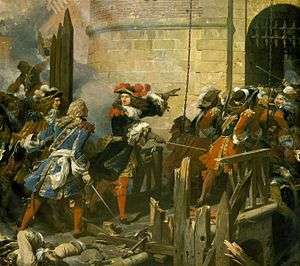Siege of Valenciennes (1676–77)
| Siege of Valenciennes | |||||||
|---|---|---|---|---|---|---|---|
| Part of the Franco-Dutch War | |||||||
 Musketeers of the Guard entering the citadel of Valenciennes | |||||||
| |||||||
| Belligerents | |||||||
|
|
| ||||||
| Strength | |||||||
| 60,000 | 3,000 | ||||||
The Siege of Valenciennes took place from November 1676 to March 1677, during the Franco-Dutch War. A French army besieged the city of Valenciennes, which was then a part of the Spanish Netherlands and defended by a small army of the Holy Roman Empire. The city surrendered to the French on 17 March. It was formally ceded to France the following year in the Treaty of Nijmegen, which ended the war.
Context
On the death of Henri de la Tour d'Auvergne, Vicomte de Turenne at the battle of Salzbach, the French army retreated and recrossed the Rhine. Louis XIV appointed Louis II de Bourbon-Condé to replace him. He stopped the advance of Montecuccoli, and took the seats of Haguenau and Saverne. Tormented by gout, the Grand Condé in Chantilly decided to retire, matched in this by Montecuccoli. Louis XIV did not continue fighting given his capture of Condé and Bouchain.
Preparations
In November 1676, Louvois laid siege to the city of Valenciennes. To prevent Spain from supporting Valenciennes, troops laid siege to Saint-Omer and Cambrai. Valenciennes was well-fortified. The defenders flooded the surroundings and settled in to wait for reinforcements.
Journeying to Valenciennes, Louis XIV was accompanied by his brother and marshals d'Humières, Schomberg, La Feuillade, Luxembourg and Lorges who were all successful.[1] Vauban commanded the operation.
The plan was not to attack the bastions, half-moons and other works, to avoid being seen by the enemy. Against the advice of the marshals, and to the astonishment of the king, Vauban advocated a daylight attack to create surprise and did not give the enemy time to recover from a night vigil.
The assault
17 March at 9:00 am, two companies of Musketeers, a hundred grenadiers, a battalion of Guards and a regiment of Picardy went over the top of the Grand Couronne. They achieved complete surprise and continued killing the enemy. The musketeers lowered the drawbridge and entered the city, progressing from house to house. The city council soon assembled and sent deputies to the King to negotiate surrender.
Notes and references
- ↑ France Annales historiques - page 54
Sources
France Annales historiques De Philippe Le Bas - 1843
Coordinates: 50°21′25.61″N 3°31′6.00″E / 50.3571139°N 3.5183333°E